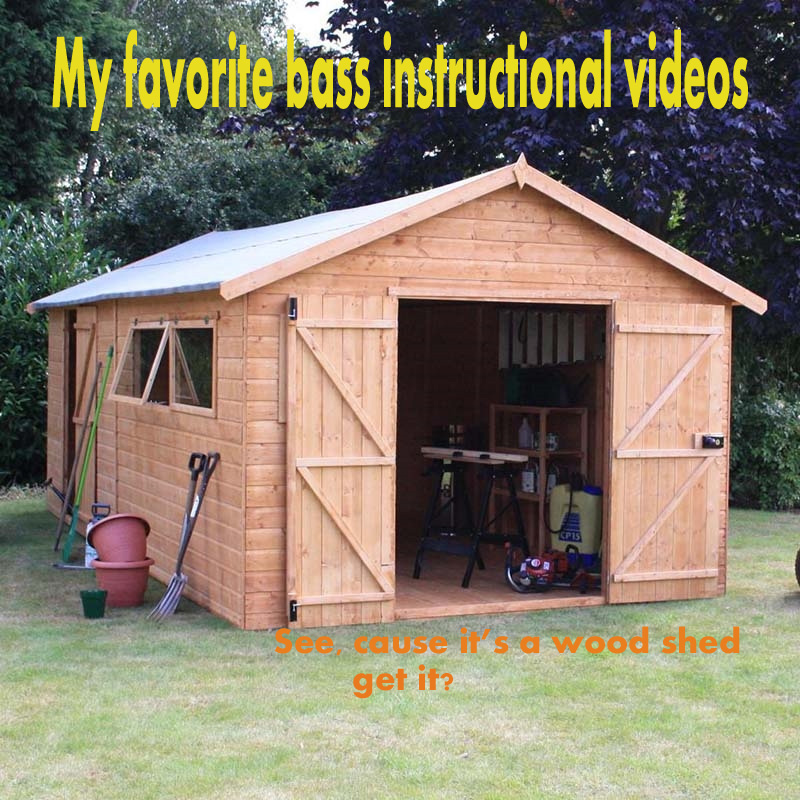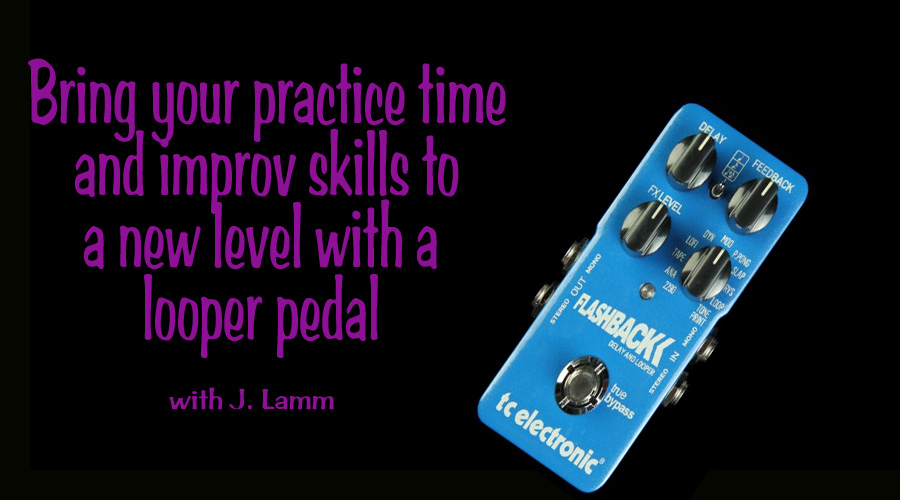I got into instructional videos much later on into my musical training. I’m talking about twenty years into it. See, the way I started out was taking private lessons; I then supplemented these private lessons by going through all the lessons in magazines like “Guitar For the Practicing Musician” and “Bass Player.” I had a bad run of experiences with bass instructional videos. It seemed to me that all the ones I was checking out were just reiterating the same old scales and warm up techniques. Who wants to learn that?
That’s why I sought out instructional videos that got me playing things I’d never done before. And if you want to take your playing to the next level then check out some of my favorite instructional home videos.
First off, I want to apologize for how long it’s been since posting articles. Over the past couple of months I’ve been working on two writing projects that completely sapped up all my time. I was writing every free chance I had. And, of course, when you’re done writing you have to edit, edit, edit.
Anyway…
 One of the first instructional home videos I ever bought was John Myung’s “Progressive Bass Concepts.”
One of the first instructional home videos I ever bought was John Myung’s “Progressive Bass Concepts.”
I hated it. I thought it went over very basic things that most players have already learned. And with a title like “progressive bass concepts” I thought it would be ideas far beyond what I’ve already learned. Sure, it covered some tapping stuff, but big deal. I’m sure for some players out there this video might help them with their speed in right hand finger-playing but for me it didn’t cover any new ground at all.
Nothing against John Myung or anything, it’s just that I already knew the stuff contained in the video. When I had a private teacher I learned all the scales, exercises, tapping techniques, etc. My goal in seeking out instructional videos was to discover some things I had never learned before.
This video would discourage me from checking out any other video for a long time. I mean, the god damn thing cost me more than 40 bucks to buy. Why are instructional video so expensive? Do those booklets really cost an arm and a leg to produce?
So it wasn’t for years later that I actually hit a wall with my learning process. Boy, was I wrong.
I wanted to discover why players like Steve Bailey and Victor Wooten were regarded as some of the best players around. For me, those guys play in a style that I’m not too interested in. By that, I mean jazz. I have very little interest in jazz music. I only get excited about it if the music is focused on the bass guitar and has a darker vibe to it. Jazz music to me has always come across as a bunch of hipsters toying around on stage without a care in the world if they’re playing in tune or not. It’s focus is primarily on the phrasing of the content…no matter if that content is in key or not. It annoys me. But, I would soon learn, there are many types of jazz out there. It would take a while for me to discover the kind that I would like.
Happy sounding jazz can bite my ass. No thank you to all that. Acid Jazz is unlistenable horseshit to me. Future Jazz is ok in small doses. Fusion, for the most part, is pretty cool. Yes, there is a whole slew of sub-genres of jazz. Just like there is a whole batch of sub-genres in metal.
But, you can sure learn a lot from players that are associated with genres outside your own field of interest. That’s why I hunted down the Steve Baily and Victor Wooten duo instructional home video. And it really changed my way of thinking about home video learning.

This video has two players that are very different from one another. Steve Bailey mainly plays a 6-string fretless bass; Victor Wooten mainly plays a 4-string bass and primarily with his thumb as a pick. They both have two different takes on playing that compliment one another.
This video taught me all about “harp harmonics” and introduced me to the double-thump technique.
It was an introduction, however. I would have to search out other videos by Bailey and Wooten to really delve into Wooten’s thumb technique and Bailey’s mastery of the 6-string fretless. Steve Bailey’s videos deal mostly with the fretless: how to play in tune, how to get a good vibrato, and how to use thumb position (a technique normally used on the upright bass). Victor Wooten’s videos mainly deal with double-thumping and a variety of other right hand plucking variations. He also covers a lot of ground when it comes to improvisation and the philosophy of being a musician.
That brought me to Victor Wooten’s Groove Workshop.

Groove Workshop is kind of a unique video. You’ve got Victor Wooten and Anthony Wellington in front of a class of bass players doing a clinic. In this video you learn about Wooten’s theory about music being a “language.” It’s a theory that I agree with in parts but I also disagree with in other ways.
It’s an insightful video to go through. I didn’t learn much about technique but I did walk away from it with a better understand on how to approach soloing and improvisation. I was also introduced to Anthony Wellington, a very great teacher and music communicator. I’ve since been to his website and learned a whole new approach to rhythm patterns in the slap/pop technique that utilizes a series of finger flicks and not just thumping and popping.
After those videos I went on a whole run of checking out instructionals by T.M. Stevens, Gary Willis, Stu Hamm, Billy Sheehan, Jaco Pastorius, Bill Dickens, videos for the upright bass, and videos by guitar players like Guthrie Govan and keyboardists like Jordan Rudess.
As a musician that primarily plays the bass I think it’s important for me, and other musicians, to learn from guitar players, keyboardists, etc. If you’re a bass player and want to learn a great picking technique I would suggest checking out Paul Gilbert and Michael Angelo Batio. Don’t be one of those bass players that only wants to learn from other bass players. Look to keyboardists, violinists, singers, and drummers for ideas on how to approach the bass. For example, Victor Wooten took the heel-toe drumming technique and applied it to his right hand technique on the bass. It’s innovative things like that that really get me excited about practice.
 Then I found a great video by Michael Manring – my favorite bass player. Michael Manring has really taken the bass guitar and propelled it far beyond what other people are doing with the instrument. With his use of ebow, alternate tunings, hipshot tuners, bridge tuners, piccolo strings, multiple instruments at a time, etc. etc. etc. Checking out this video will awaken your creativity and have you going out to pick up your own ebow.
Then I found a great video by Michael Manring – my favorite bass player. Michael Manring has really taken the bass guitar and propelled it far beyond what other people are doing with the instrument. With his use of ebow, alternate tunings, hipshot tuners, bridge tuners, piccolo strings, multiple instruments at a time, etc. etc. etc. Checking out this video will awaken your creativity and have you going out to pick up your own ebow.
For years I had been listening to albums by Manring and thought he was getting his tone from effects and shenanigans. Nope, that’s the ebow, his instrument and his incredible playing.
 The last video I’ve been going through is by Troy Tipton of Cynthesis and Zero Hour. This video talks a lot about sweep picking without a pick, flamenco style finger picking, and tapping. It’ll definitely get you practicing some skills that you’ve probably never done before. I still practice several of these exercises from the video with my metronome.
The last video I’ve been going through is by Troy Tipton of Cynthesis and Zero Hour. This video talks a lot about sweep picking without a pick, flamenco style finger picking, and tapping. It’ll definitely get you practicing some skills that you’ve probably never done before. I still practice several of these exercises from the video with my metronome.
So those are the videos that I’ve currently been going through. I hope you have a chance to seek some of them out because, for me, they opened my eyes to new techniques and skills that I can see myself putting to good use.
I think it’s important for musicians to know as much as they can about the variety of playing styles and techniques that are currently out there. You never know, one day you could be a hired musician and your musical director might ask you to play something crazy. If you have a diverse background in techniques you should be able to whip it out and be able to do what anyone asks of you. If not, you’ll have to woodshed that shit until you can get it sounding passable.
One of these days I’m going to put out my own instructional video and it will just be about practical things: learning how to get to a point in your playing where you can go into a recording studio and record bass tracks without looking like a fool. This would be in stark contrast to most instructional videos where the teacher shows off a bunch of flashy horseshit you’ll probably never have the opportunity to display.
Sure, we all want to learn the flashy stuff but I think most bass players need to learn how to play clean, have great tone, and be diverse. There’s nothing worse than a bass player recording something while having no regard to how the other strings are flopping around in the breeze as they bang away at the neck. Fuck, learn how to dampen those strings, people.
Have a nice day.





